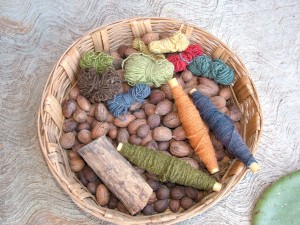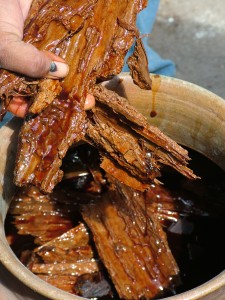On this page we have assembled resources relating to our excursion to Teotitlán del Valle, a textile town and the site of a bilingual school where some of our NEH Summer Scholars have established international conversations.
The weaving or rugs and other textiles is a major economic activity in Teotitlán del Valle. In excursions rrom previous years we have visited a women’s cooperative where we learned about the production process and got to see a variety of finished products. One project that would be very welcomed would be to interview weavers about specific designs, asking about their meaning. Lightning, for instance, is a prominent motif. Lightning relates to rain, rain to fertility, and therefore agricultural abundance and the sustenance human life. Can you find a detail that represents lightning?
The church in Teotitlán del Valle is built upon the ruins of a pre-Columbian Zapotec temple. Stones from that temple were re-purposed for the construction of the Christian church during Spanish colonization. There are others; see if you can find more. Ask the local people what these symbols mean to them, if they still have a specific meaning, that is — beyond a general reverence as something from antiquity.

Entrance to Zapocactus, the home of the Familia González, No. 24A, Calle 5 de Mayo, Teotitlán del Valle. (S. Wood, 2007)

A jar with dried cochineal for producing a red dye. Famlia González. Teotitlán del Valle. (S. Wood, 2007)

Petra Vicente grinds the cochineal with a metate. Famlia González. Teotitlán del Valle. (S. Wood, 2007)

Nuts, another source of natural dyes. And yarn spindles. Famlia González. Teotitlán del Valle. (S. Wood, 2007)
We are guided in Teotitlán del Valle by Professor Lynn Stephen, who has lived there and published extensively about the culture. Here, we visit a “milpa” (cornfield, derived from the Nahuatl word milli, field) to learn about the planting of the triad or “three sisters,” corn, beans, and squash. Lynn introduced us to Paco González, her compadre (co-godparent). At the end of this visit, Paco’s brother shared vocabulary relating to cultivation in the Zapotec language.
Here’s another milpa where the plants are farther along in the cycle. The sacred mountain appears in the background:
Here’s a close-up of the mountain, but still as a back-drop, this time in a photograph taken of a local Christian festival, the Fiesta de la Santa Cruz (Holy Cross).
In the home of Paco and his mother, we are given demonstrations for making natural dyes, which are so prevalent in the making of rugs and other textiles that are central to the economy of Teotitlán del Valle.
We are also treated by Paco’s mother to an explanation of the elements on her home altar that have both indigenous and European origins.
CEED/CIED
“Culture, Exchange, Education, and Diversity / Cultura, Intercambio, Educación, y Diversidad” (CEED/CIED)
While in Teotitlán del Valle we also hope to visit a bilingual school. Although school won’t be in session, we hope to meet with a team that has been working to develop trans-border conversations between Spanish-speaking youth (often heritage speakers) in the United States and youth in Teotitlán. We involve these young people in conversations to help them practice their Spanish and to share information about their cultures. Sometimes we focus on the impact of migration on the community in Mexico and on the people who are abroad, in the U.S. We had a small grant in 2012 to help fund these conversations. Two school teachers from our 2010 NEH Summer Institute have also participated, involving their students in Connecticut and California. Here is a PDF with a short article on the project; see page 5, the article about CEED/CIED.
Video Clips
- Teotitlán del Valle (by Gabriela Martínez), http://www.youtube.com/watch?v=Zf0cDz22LzA (from March 2010)













